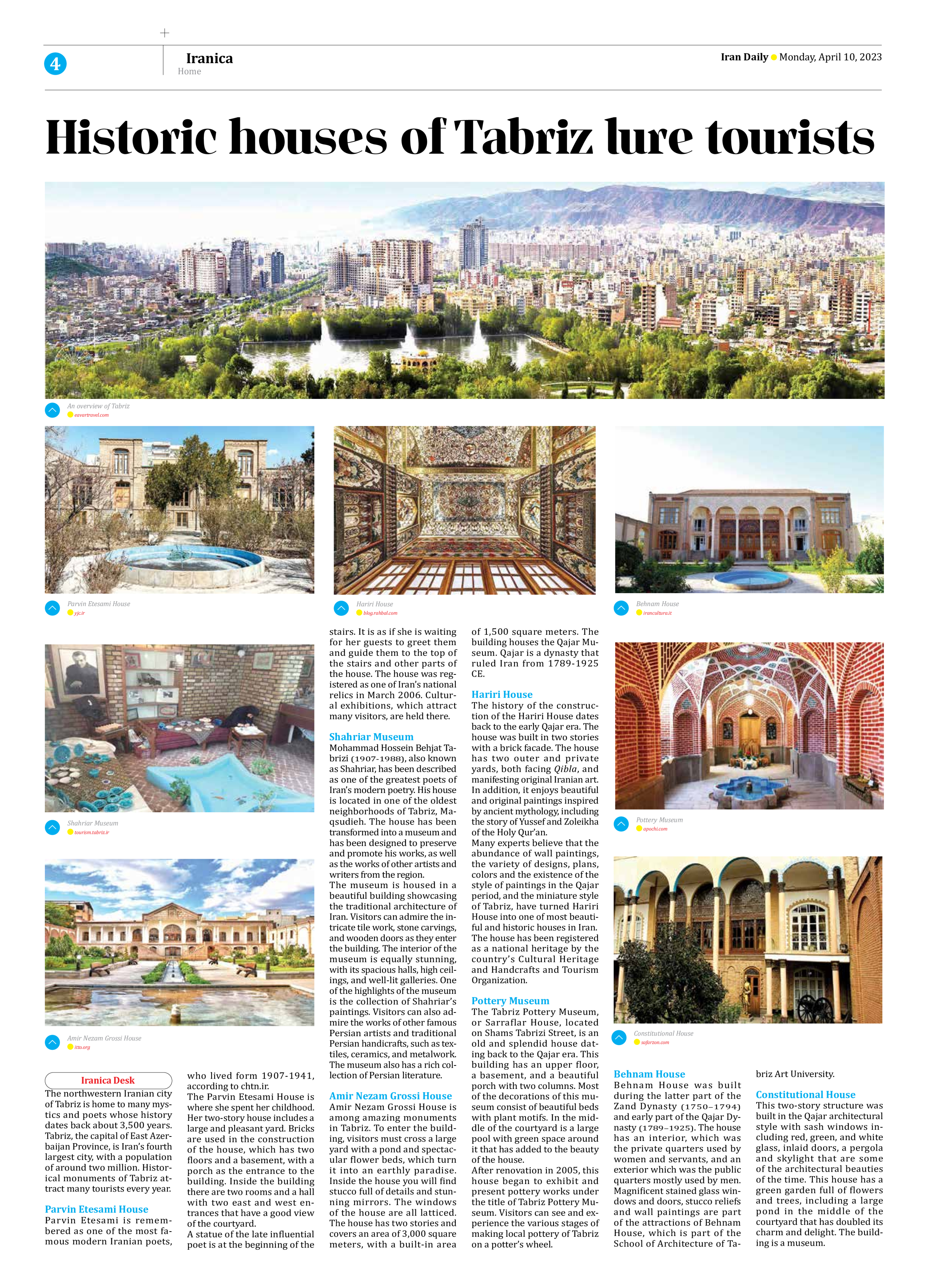
Historic houses of Tabriz lure tourists
The northwestern Iranian city of Tabriz is home to many mystics and poets whose history dates back about 3,500 years. Tabriz, the capital of East Azerbaijan Province, is Iran’s fourth largest city, with a population of around two million. Historical monuments of Tabriz attract many tourists every year.
Parvin Etesami House
Parvin Etesami is remembered as one of the most famous modern Iranian poets, who lived form 1907-1941,
according to chtn.ir.
The Parvin Etesami House is where she spent her childhood. Her two-story house includes a large and pleasant yard. Bricks are used in the construction of the house, which has two floors and a basement, with a porch as the entrance to the building. Inside the building there are two rooms and a hall with two east and west entrances that have a good view of the courtyard.
A statue of the late influential poet is at the beginning of the stairs. It is as if she is waiting for her guests to greet them and guide them to the top of the stairs and other parts of the house. The house was registered as one of Iran’s national relics in March 2006. Cultural exhibitions, which attract many visitors, are held there.
Shahriar Museum
Mohammad Hossein Behjat Tabrizi (1907-1988), also known as Shahriar, has been described as one of the greatest poets of Iran’s modern poetry. His house is located in one of the oldest neighborhoods of Tabriz, Maqsudieh. The house has been transformed into a museum and has been designed to preserve and promote his works, as well as the works of other artists and writers from the region.
The museum is housed in a beautiful building showcasing the traditional architecture of Iran. Visitors can admire the intricate tile work, stone carvings, and wooden doors as they enter the building. The interior of the museum is equally stunning, with its spacious halls, high ceilings, and well-lit galleries. One of the highlights of the museum is the collection of Shahriar’s paintings. Visitors can also admire the works of other famous Persian artists and traditional Persian handicrafts, such as textiles, ceramics, and metalwork. The museum also has a rich collection of Persian literature.
Amir Nezam Grossi House
Amir Nezam Grossi House is among amazing monuments in Tabriz. To enter the building, visitors must cross a large yard with a pond and spectacular flower beds, which turn it into an earthly paradise. Inside the house you will find stucco full of details and stunning mirrors. The windows of the house are all latticed. The house has two stories and covers an area of 3,000 square meters, with a built-in area of 1,500 square meters. The building houses the Qajar Museum. Qajar is a dynasty that ruled Iran from 1789-1925 CE.
Hariri House
The history of the construction of the Hariri House dates back to the early Qajar era. The house was built in two stories with a brick facade. The house has two outer and private yards, both facing Qibla, and manifesting original Iranian art. In addition, it enjoys beautiful and original paintings inspired by ancient mythology, including the story of Yussef and Zoleikha of the Holy Qur’an.
Many experts believe that the abundance of wall paintings, the variety of designs, plans, colors and the existence of the style of paintings in the Qajar period, and the miniature style of Tabriz, have turned Hariri House into one of most beautiful and historic houses in Iran.
The house has been registered as a national heritage by the country’s Cultural Heritage and Handcrafts and Tourism Organization.
Pottery Museum
The Tabriz Pottery Museum, or Sarraflar House, located on Shams Tabrizi Street, is an old and splendid house dating back to the Qajar era. This building has an upper floor, a basement, and a beautiful porch with two columns. Most of the decorations of this museum consist of beautiful beds with plant motifs. In the middle of the courtyard is a large pool with green space around it that has added to the beauty of the house.
After renovation in 2005, this house began to exhibit and present pottery works under the title of Tabriz Pottery Museum. Visitors can see and experience the various stages of making local pottery of Tabriz on a potter’s wheel.
Behnam House
Behnam House was built during the latter part of the Zand Dynasty (1750–1794) and early part of the Qajar Dynasty (1789–1925). The house has an interior, which was the private quarters used by women and servants, and an exterior which was the public quarters mostly used by men. Magnificent stained glass windows and doors, stucco reliefs and wall paintings are part of the attractions of Behnam House, which is part of the School of Architecture of Tabriz Art University.
Constitutional House
This two-story structure was built in the Qajar architectural style with sash windows including red, green, and white glass, inlaid doors, a pergola and skylight that are some of the architectural beauties of the time. This house has a green garden full of flowers and trees, including a large pond in the middle of the courtyard that has doubled its charm and delight. The building is a museum.







